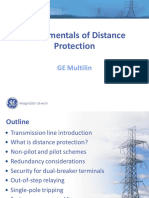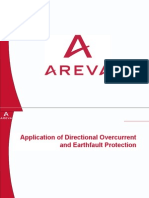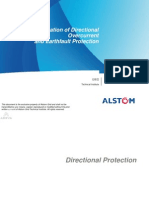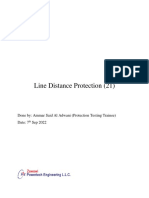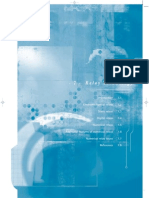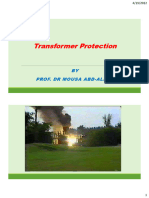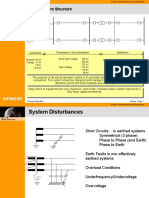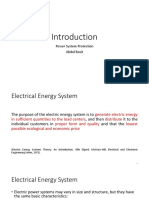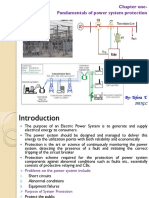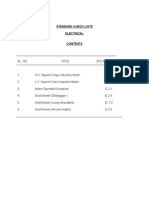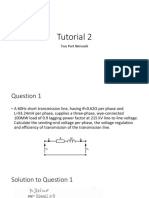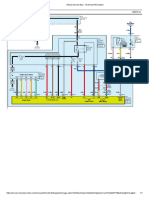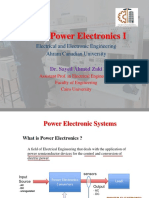Power Transmission and Distribution
Power System Structure
No. 1 with
Energy Automation
Generation
Medium 24 kV
Voltage 21 kV
15 kV
13.8 kV
Transmission / Sub transmission
Extra High Voltage
High Voltage
765 kV
400 kV
220 kV
132 kV
110 kV
66 kV
Distribution
Medium Voltage
33 kV
22 kV
11 kV
The
Thepurpose
purposeofofan
anelectrical
electricalpower
powersystem
systemisistotogenerate
generateand
andsupply
supplyelectrical
electricalenergy
energytoto
consumers.
The
system
should
be
designed
and
managed
to
deliver
this
energy
consumers. The system should be designed and managed to deliver this energytotothe
the
utilisation
points
with
both
reliability
and
economy.
utilisation points with both reliability and economy.
Many
Manyitems
itemsofofequipment
equipmentare
arevery
veryexpensive,
expensive,and
andso
sothe
thecomplete
completepower
powersystem
systemrepresents
representsaa
very
verylarge
largecapital
capitalinvestment.
investment.
..
Energy Automation
Badiya Page 1
�Power Transmission and Distribution
System Disturbances
No. 1 with
Energy Automation
Short Circuits in earthed systems
Symmetrical (3 phase)
Phase to Phase (and Earth)
Phase to Earth
Earth Faults in non effectively
earthed systems
Overload Conditions
Underfrequency/Undervoltage
Overvoltage
Energy Automation
Badiya Page 2
�Power Transmission and Distribution
Protective Relaying
No. 1 with
Energy Automation
Role of Protection
Protective Relaying is the most important feature of
power system design aimed at minimising the
damage to equipment and interruption to service in
the event of faults.
It is therefore a co-factor
among other factors resorted to improve reliability
of power system.
Energy Automation
Badiya Page 3
�Power Transmission and Distribution
The Purpose of Protection
No. 1 with
Energy Automation
The protection can not prevent system faults,
But it can:
Limit the damage caused by short
circuits
While:
Protecting people and plant from
damage
Selectively clearing faults in
miliseconds
Protecting plant from overload
conditions
Power system must operate in a safe manner at all times.
Energy Automation
Badiya Page 4
�Power Transmission and Distribution
Causes and Probability of System Disturbances
No. 1 with
Energy Automation
Causes
Operator Mistakes
Pollution/Condensation
Equipment failures, e.g. P.T.'s, Isolators
Transient Overvoltages
Probability
System faults (220/400 kV):
3p.a. and 100 km
10-20 kV metal clad switchgear: 10-3 p.a. and feeder
GIS switchgear:
5-10-2 p.a. and bus
outdoor switchgear: 110/132 kV 7*10-2 p.a. -1and bus
220/275 kV
10 p.a. and bus
400 kV
2*10-1 p.a. and bus
Energy Automation
Badiya Page 5
�Power Transmission and Distribution
Principles of Relaying
No. 1 with
Energy Automation
Since protective relaying comes into action at the time of
equipment distress, a certain safeguard is necessary in
the unlikely event of its failure to act at the hour of need.
Hence, two groups of protective schemes are generally
employed a)
Primary Protection
b)
Back-up Protection
Primary Protection is the first line of defense, whereas
back-up relaying takes over the protection of equipment,
should the primary protection fail.
Energy Automation
Badiya Page 6
�Power Transmission and Distribution
Primary Protection
No. 1 with
Energy Automation
The Primary Protection has following characteristic features 1.
It has always a defined zone of operation.
2.
It should operate before any back-up protection
could operate, therefore, it should be faster in
operation.
3.
It should be able to completely isolate the fault
from all the current feeding sources.
4.
Energy Automation
It should be stable for all operating conditions.
Badiya Page 7
�Power Transmission and Distribution
Back-up Protection
No. 1 with
Energy Automation
1.
Back-up protection should provide sufficient time
for the primary protection to perform its duty.
2.
Back-up protection covers a wider zone of
protection. Therefore, there is always a possibility
of large scale disturbance, when back-up relays
operate.
3.
Under primary protection failure, several back-up
relays may operate for complete isolation of fault.
Energy Automation
Badiya Page 8
�Power Transmission and Distribution
Reasons of Primary Protection Failure
No. 1 with
Energy Automation
Primary protections failure could be due to any of the
following reasons 1. Current or Potential Transformer failure
2. Loss of Auxiliary Control Voltage
3. Defective Primary Relays
4. Open Circuits in Control & Trip Coil
5. Failure of Breaker
It is therefore logical that back-up relays should not
utilise any of the above items as common with primary
relays.
Energy Automation
Badiya Page 9
�Power Transmission and Distribution
Protection Concept
No. 1 with
Energy Automation
Circuit Breaker
CT / VT
Cabling
DISTANCE RELAY
Protection
Energy Automation
Battery
The system is only as strong as the weakest link!
Badiya Page 10
�Power Transmission and Distribution
No. 1 with
Energy Automation
Basic Protection
Requirements
Reliability
dependability (availability)
high dependability = low risk of failure to trip
Security
stable for all operating conditions ,
high security = low risk of over-trip
Speed
high speed minimizes damage
high speed reduces stability problems
Selectivity
trip the minimum number of circuit breakers
Sensitivity
notice smallest fault value
Energy Automation
Badiya Page 11
�Power Transmission and Distribution
Zones of Protection
No. 1 with
Energy Automation
To limit the extent of the power system that is disconnected when a fault
occurs, protection is arranged in zones
Zones of protection should overlap, so that no part of the power system is left
unprotected
Location of the CT connection to the protection usually defines the zone
Unit type protections have clear zones reach e.g Diff. Relay, REF relay
Zone reach depends on measurement of the system quantities e.g OC , EF,
distance relays . The start will be defined but the extent (or reach) is subject
to variation, owing to changes in system conditions and measurement errors.
Energy Automation
Badiya Page 12
�Power Transmission and Distribution
Protection - One Out of Two Principle
No. 1 with
Energy Automation
System
1
Trip
Coil
1
Trip
Coil
2
System
2
Battery 1
Battery 2
Energy Automation
Badiya Page 13
�Power Transmission and Distribution
Redundancy Concept of DC Circuits
No. 1 with
Energy Automation
Battery 1
Battery 2
Main Protection
Back-up Protection
87T
TR
TC 1
L-
Energy Automation
87BB
50/51
TR
TC 2
Busbar Protection
BF
TR
Trip remote infeed
L-
Badiya Page 14
�Power Transmission and Distribution
Factors that influence fault current magnitude
No. 1 with
Energy Automation
Infeed
Line
Consumer
G
Short circuit power of the infeed
Voltage level
Line impedance
Fault resistance (arc)
Treatment of star point
Estimate of short circuit currents:
Medium Voltage (10 kV upto 30kV)
High Voltage (110 kV)
Extra High Voltage (220kV + )
Energy Automation
ISCmin > ILmax
ISCmin >= ILmax
ISCmin = 0,25 ILmax
Badiya Page 15
�Power Transmission and Distribution
Earth faults: Star-point configuration
No. 1 with
Energy Automation
earthed system
Earth fault = short circuit
is recognised by normal
over-current protection.
With low impedance earthing
the residual current detection
must be more sensitive.
Energy Automation
Peterson Coil
isolated neutral
Earth faults = no short circuit
Supply is not disrupted
Earth fault must be alarmed and removed
as fast as possible
Earth fault location is achieved with
wattmetric earth fault detection
Badiya Page 16
�Power Transmission and Distribution
Protection Criterion - Current
No. 1 with
Energy Automation
The overcurrent condition is evaluated I>
Suitable for:
I>
ILmax
I
ISCmin
Additional criterion - Time
(to ensure selectivity)
Protection:
Fuses
inverse time protection
definite time protection
Energy Automation
(IDMT)
(DT)
Badiya Page 17
�Power Transmission and Distribution
Protection Criterion - Current Difference
No. 1 with
Energy Automation
Evaluation of node I1 + I2 + I3 + ... In = 0; if the equation is not
satisfied the fault is internal
Security is increased by stabilisation |I1|+|I2|+ ... |In| = Istab
Characteristic:
Idiff
Trip
Istab
definite distinction internal / external faults (no back-up)
Protection:
Line differential protection
Generator-, motor-, transformer differential protection
Busbar protection
Energy Automation
Badiya Page 18
�Power Transmission and Distribution
Protection Criterion - Impedance
No. 1 with
Energy Automation
From the voltage and current signals the
impedance is calculated
The impedance is proportional to the fault distance
Characteristic:
X
Z<
R
Additional criterion - Time
(Required for selectivity and back-up protection)
Protection:
Multiple stage distance protection
Energy Automation
Badiya Page 19
�Power Transmission and Distribution
Measured signals and time grading principle
No. 1 with
Energy Automation
A
Protected object
Protection
device
Example distance protection
t
t3
t2
t1
A
Energy Automation
Z1
Z2
Badiya Page 20
�Power Transmission and Distribution
Comparison Protection Principle
No. 1 with
Energy Automation
A
Protected object
Protection
device
Protection
device
communication
momentary values/
binary decisions
Protection
device
Energy Automation
Badiya Page 21
�Power Transmission and Distribution
Typical Distance Zone Characteristics
No. 1 with
Energy Automation
MHO-circle
ZA
ZSC'
X
starting zone
external
fault
ZSC
combined circleand straight line
characteristic
Zone 3
internal
fault
Zone 2
Zone 1
R
X
polarised
MHO-circle
polygonal tripping
characteristic
(quadrilateral)
RF
ZS = 0
ZL
R
X
XA
settable arc compensation
ZL
RLB
ZS small
RA
ZS large
ZS
Energy Automation
Badiya Page 22
�Power Transmission and Distribution
Further Typical Protection Criteria
No. 1 with
Energy Automation
Current increase
Under and over voltage
Directional comparison
Phase comparison
Power direction
Phase angle
Over and under frequency
Frequency gradient
Harmonics
Special criteria in machine protection
Energy Automation
Badiya Page 23
�Power Transmission and Distribution
Typical Protected Objects
No. 1 with
Energy Automation
Generators
< 1MVA upto 1500 MVA
Transformers
0,1 MVA upto 1000 MVA
Busbars
from 110 kV up to 750kV
Lines
from 1kV upto 750 kV
Motors
approx. 100 kVA upto 20 MVA
Reactors, Capacitor etc.
Energy Automation
Badiya Page 24
�Power Transmission and Distribution
Redundancy Concepts
No. 1 with
Energy Automation
Busbar Protection
Line Protection
1 out of 2 principle
LP1
LP2
trip line
Energy Automation
1 out of n principle
&
trip section 1
&
trip section 2
Check
Zone
Transformer Protection
Relay
1
.
.
.
Relay
n
Section
1
2 out of 2 principle
Section
2
trip transformer
Badiya Page 25
�Power Transmission and Distribution
Stability Limits in Transmission System
No. 1 with
Energy Automation
70
stability limit
60
Protection 50
Fault
Clearing 40
Time
30
ms
20
10
0
1300
Energy Automation
1400
1500
1600
1700
1800
1900
2000
Line
Load
MW
Badiya Page 26
�Power Transmission and Distribution
Failure Rate of Redundant Systems
No. 1 with
Energy Automation
0.12
0.1
Failure
rate
active failure (over trip)
0.08
0.06
0.04
passive failure (under trip)
0.02
0
1
Energy Automation
number of relays
10
Badiya Page 27
�Power Transmission and Distribution
Why Digital Protection?
No. 1 with
Energy Automation
Integration of the protection functions for one feeder:
Feeder protection device
Example: overhead line of extra high voltage
Energy Automation
Distance protection with I>> or u</i>-exitation
Three-pole reclosure
Directional earth fault detection
Fault location
Event log
Fault recording
Badiya Page 28
�Power Transmission and Distribution
Why Digital Protection?
No. 1 with
Energy Automation
Self-supervision
Raising of the availability
Plausibility control of the input values
Supervision of the a/d-conversion
Internal testing of the computer systems (watch-dog)
Supervision of the memory chips
Testing the trip-relay-coil
Energy Automation
Badiya Page 29
�Power Transmission and Distribution
Contact Terms
No. 1 with
Energy Automation
Contacts provide electrical outputs for tripping and remote
indication purposes
Self-reset
The contacts remain in the operated condition only while the controlling quantity is applied,
returning to their original condition when it is removed.
Hand or electrical reset
These contacts remain in the operated condition after the controlling quantity is removed. They
can be reset either by hand or electrically by an auxiliary electromagnetic element
A 'make' contact
is one that closes when the relay picks up
A break contact
is one that is closed when the relay is de-energised and opens when the relay picks up.
Energy Automation
Badiya Page 30



